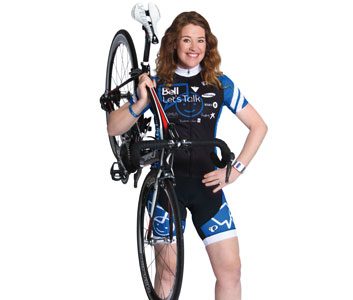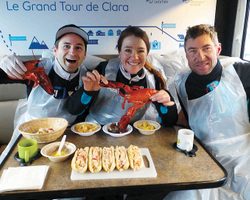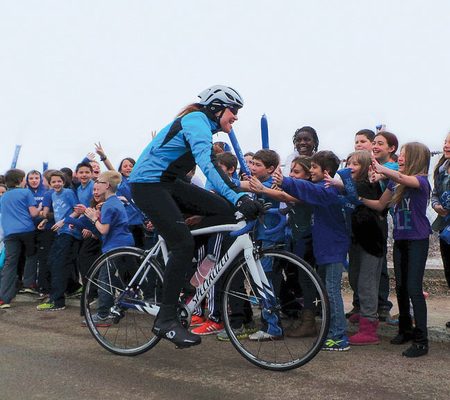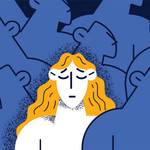Clara Hughes on the ‘Ride’ of her life
We sat down with Clara Hughes a few days before she began the epic 12,000 kilometre, 110-day ride known as ‘Clara’s Big Ride’

Source: Best Health magazine, Summer 2014
In case you hadn’t heard, Clara Hughes is cycling the circumference of Canada. Seriously. ‘It’s a privilege,’ she says. ‘I’m lucky.’ The celebrated Olympian, 41, started on March 14 in Toronto and will finish on July 1 on Parliament Hill. She’ll have pedalled some 12,000 kilometres over 110 days, and have met thousands of Canadians at 200 community stops in each province and territory. (The 12,000 kilometres is distance she is covering by bike; there are sections she and the team are to fly over, such as from Yellowknife to Inuvik.)
The purpose of ‘Clara’s Big Ride‘ is to get people talking about mental illness and erase the stigma. It’s an initiative that grew out of the Bell Let’s Talk campaign, for which Hughes is spokesperson; she herself has struggled with mental illness. Corporate Canada is covering the Ride expenses, and Hughes is donating her time for it. Communities and companies can raise money, if they wish, to give directly to mental health initiatives of their choice. For example, Hughes was riding through Iqaluit in early May when NorthwesTel presented a $68,000 cheque to Nunavut Help Line.
Hughes’ husband of 18 years, Peter Guzman, is doing the entire Ride with her, and Hughes has lined up three close cyclist friends who, one at a time, will join them along the way. At press time, she and her team were about half-finished, having pedalled roads in Ontario, Quebec, Atlantic Canada, all three territories’including the Arctic Circle and Dempster Highway’B.C. and Alberta. Next up are the Prairie provinces, and she’ll re-enter Ontario in mid-June.
Each day means a ride of anywhere from less than 100 kilometres up to about 200, with most Sundays as rest days. It’s an unheard-of feat”epic,’ as Hughes herself rightly describes it. But don’t even think about suggesting that the work she’s doing for mental health awareness is on the scale of what Terry Fox did to raise cancer awareness. ‘No, no, no,’ she firmly responds. ‘This isn’t about me or one person. My name is attached to the Ride, but I agreed to that only because many people know who I am and feel comfortable approaching me. But it’s about the Canadian story that is different in every community, and I just can’t wait for that story to be told. After this Ride, I hope it’s continued in some way year after year, with people doing their big ride, or their big walk, or their big yoga day or their big whatever’all for mental health. That’s what I dream of.’
As the magazine partner for Clara’s Big Ride, Best Health had the chance for a candid talk with her on a cold, snowy morning in Toronto just days before she headed out on the ride of her life. We’ve been checking in along the way for updates.
How did Clara’s Big Ride come about?
I used to think, What am I doing training for the Olympics when there’s so much that needs to be done in mental health? So after the London Olympics in 2012, I realized I finally had the time I wanted. What would I do with it? It’s the same as when I’d be standing at the start line, say at a skating race, and I’d be terr-i-fied. I’d be thinking, Oh my God, you’re at the Olympics. Four minutes and you’re done.’what are you going to make those four minutes? So after London I was on a distance hike with Peter and I had this moment of, Okay, I’m no longer an athlete. I don’t know who I am, but I’m moving, and I feel good. And it’s so important for me to be in nature, connecting with myself, feeling my body, that I thought, How can I give this feeling, how can I give an ounce of this feeling and demonstrate the importance of movement as medicine?
And that’s when I had the idea for the Ride. Bell Let’s Talk Day is one day in the year, but I wanted to make it something more. Everyone we’re working with at Bell to make this happen genuinely cares, and has a sense of pride in what they’re doing here. It’s a really beautiful team environment.
You first experienced depression after your first Olympics in 1996. Did you worry it would hit again after you retired in 2012?
I struggled with depression while competing, because of the pressure and expectations from outside and inside; I go into this place. So after London 2012, I figured it wouldn’t be so hard. A few months went by, we’d decided this Ride would happen, I was busy’and the moment I stopped, when I had a few weeks when I didn’t have to travel or do anything, I started feeling that weight again. Feeling just heavy. I was walking on the road where we live, in the back country in Utah, and felt disconnected with myself’. I was going back into that place. That’s when I knew my depression wasn’t about the pressure of sport’it’s me. I’d thought I could do this alone. No way. So I started working with a psychologist in early 2013. It really helped. I went through a lot and was just crying, crying, crying in his office and getting a lot of stuff out. He has helped me find peace with certain things and realize I’m not a superperson, I can’t just change myself or the world, that there’s a lot of work I need to do on myself with the help of a professional.
But most people don’t have that person to talk to. I wonder about all the people I meet and how they are feeling. How is that mother doing whose kid has been on a waiting list for three years to see a mental health professional? And I’m not the only one thinking the situation has to be better; there’s a slew of care workers, doctors, psychologists, social workers, psychiatric nurses’of mothers, fathers, sisters, brothers, friends. So I am part of a collective push that is happening. And I’m going to play my role to its maximum. That’s what this Ride is.
Your dad died last year; I’m sorry for your loss. He struggled with mental illness, right?
He was undiagnosed, but I’ve learned enough about mental illness to know that, without a doubt, he was bipolar. But my dad was also an alcoholic. It was hard growing up with an alcoholic father. I love my dad and he inspires me; he had really beautiful traits like his sense of benevolence and his support and passion for the arts, and they absolutely live through me. But addictive, abusive, intolerant, impatient’there are many things about him that I will work hard the rest of my life to never let myself become.
And then his dementia began. For me, one of its first signs was when I called him from Vancouver in 2010 after I won my bronze [in 5,000-metre speed-skating]. My mom was with me. I said, ‘Dad, it’s Clara, did you see I won the bronze medal?’ He didn’t know who I was. I thought he was drunk. After that it got really bad. He started getting aggressive with his homecare workers, so he had to go into a geriatric psychiatric ward. I can’t thank his care workers enough. But, yeah, it is really hard. Much of what drives me is living through that and seeing someone who wouldn’t admit they had a problem. I have to try to make a difference. I can’t not try.
How tough will the Ride be?
It will be long, it will be hard. We’ve banked on an average speed of 25 kilometres per hour, which in the cycling world is not fast’but try doing 200-plus community events and riding 12,000 kilometres in 110 days! [laughs] As we go from point A to point B, I’ll be thinking about everything that happened that morning and the night before at the events. As I’m exhausting myself on the bike, I’ll be re-energizing myself and clearing my mind for what we’re stepping into next. It will be a beautiful synchronicity of energies. I want every person in the community or school to feel that their story is the most important one on this tour.
Take us through the weather you expect.
We are expecting really bad weather for much of it. But we have the best clothing and equipment, fantastic support from the bike industry’Pearl Izumi Canada, Specialized Canada, Shimano Canada. Rain will be the worst; cold is more manageable. I even expect freezing rain in Quebec and Atlantic Canada. The Dempster Highway is dirt and it should be frozen; we’re going to be riding the 800 kilometres on studded tires. But that’s going to be epic. It’s going to be so cool. I think in B.C. we’ll have a lot of rain. Then we could get snow in the Rockies. As for the Prairies? If I could control anything, I’d say please let the wind be at our backs. I’m from Winnipeg, and it’s wicked. With a headwind, you’re on your bike, going as hard as you can’and that grain elevator you saw ahead in the distance four hours ago? It’s still in the distance.
What’s the plan for fuelling your bodies?
I asked Trent Stellingwerff to plan the nutrition and vitamins. He’s an exercise physiologist and sports nutritionist based at the Canadian Sport Institute Pacific in Victoria. We’re using a holistic but science-based approach. We aren’t sponsored by anybody because we need to have a variety of foods and drinks or we’ll get totally sick of them. We will have Skratch Labs hydration drinks; I find it’s the most natural one. They use dehydrated fruit in their mix. And we bought a bunch of Gu Gels, and Kind bars are really good. But we’re going with homemade as much as we can’ homemade rice cakes with nuts and honey; sandwiches. And we’ll have hot drinks in our bottles too, like tea with honey.
In the cold, eating while riding is a problem. We have huge mitts on, so we won’t be able to go into our pockets. And water bottles would freeze. So we have a ‘follow’ vehicle and we’ll just drop back to it on our bikes and ask for a snack or whatever, and be handed bottles and unwrapped food while we ride.
What about aches and pains?
Yeah, we’re gonna be messed up! We’ll have a full-time therapist to keep us moving, and a doctor on call. We’ll use Norma-Tec [a high-tech, full-leg compression boot for quicker recovery]; they really work. Peter and I used them for training all winter.
What will you use for mental fuel?
When I’m on the bike, I’ll remind myself that if we quit, the kids will know, and everything I’ve said will be negated. So it’s not an option. I always go back to my first inspiration as a girl, watching the 1988 Calgary Olympics on TV and Gaetan Boucher was skating. He was defending champion and finished ninth’but he never gave up before the finish line. That’s fuel for me.
How important is it that Peter is with you?
I’m lucky to be married to someone who is as intensely motivated to move as I am, or even more so’and who really sees the value in this. But it took a bit of convincing; Peter is very private. He has his own comfort zone. He likes being out in the woods alone or with just one person; he’s done things like walk the Continental Divide from Canada to Mexico solo. So with this, he was like, ‘But so many people know about it.’ I told him, ‘I honestly don’t think I can do it without you.’ And so many times, I’ve given him a big hug and said, ‘I’m so grateful you’re here.’
What might the local events accomplish?
Maybe a kid will go home and say, ‘We had this thing at school and they talked about depression.’ Maybe it opens up a conversation, and opens minds. Or maybe the kid goes to the guidance counsellor. I want this to elevate the conversation so people can feel they are not alone. And my ultimate goal is for the right proportion of our healthcare dollars to be put toward mental health issues. So many people I meet who work in the system, I don’t know how they do their job. Many burn out. I want to see them given the best tools and support so they can do their job at its highest level and then go home and feel, ‘I love my work.’ There’s a lot of good stuff happening, and actually this Ride is bringing organizations together like never before. But the problem is that organizations have to scrap it out for so little funding. After this Ride is over, we’ll be able to say to the government, ‘Look how much Canadians care about this issue.’
This summer, you and Peter will be in Labrador taking Inuit kids camping for Parks Canada. But what happens on July 2?
The day after the Ride is over, I see as similar to finishing an Olympics: All I want is to wake up with Peter, look at each other and be like, ‘Did that actually happen?’ And just smile at each other and know, ‘Yup. It did.’
Since Bell Let’s Talk Day on Jan. 28, #ClarasBigRide and #Bell_LetsTalk have been used more than 100,000 times. And at the halfway mark of Clara’s Big Ride, approximately 50,000 people had attended events
We checked in with Hughes about halfway through the Ride about how she is feeling. ‘I may be in the best shape of my life’50-plus days of cycling will do that! My legs feel strong and my mind is focused on making it to the finish line and helping end the stigma around mental illness. Every single day so far has touched my heart. I’ve laughed, cried and listened’. The moments on this Ride have been some of the most memorable of my life.’
This article was originally titled "Superhuman, yet so human" in the June 2014 issue of Best Health. Subscribe today to get the full Best Health experience’and never miss an issue!




